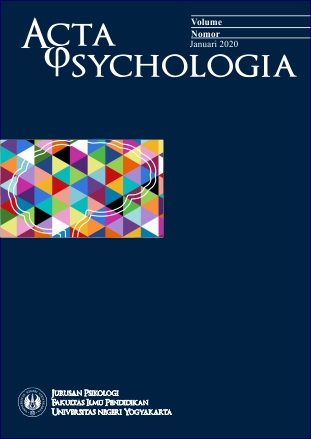Korelasi pasangan yang toksik dengan hubungan sehat mahasiswa berpacaran di Yogyakarta
DOI:
https://doi.org/10.21831/ap.v5i2.52016Keywords:
pacaran, pasangan toksik, hubungan sehatAbstract
Banyaknya pasangan terutama mahasiswa belum mengetahui pentingnya memiliki pasangan yang tepat dalam mewujudkan hubungan yang sehat. Penelitian ini bertujuan untuk mengetahui keterkaitan antara pasangan toksik dan hubungan yang sehat pada mahasiswa. Penelitian ini merupakan penelitian kuantitatif yang bersifat korelasional. Subjek dalam penelitian berjumlah 100 orang mahasiswa Yogyakarta yang sedang menjalani pacaran minimal 3 bulan. Instrumen penelitian adalah skala pasangan toksik dan skala hubungan sehat. Analisis data penelitian dilakukan dengan analisis korelasi Pearson. Hasil penelitian menunjukkan kategorisasasi pasangan toksik berada pada tingkat rendah dan kategorisasi hubungan sehat berada pada tingkat tinggi. Diketahui juga bahwa pasangan toksik memiliki korelasi dengan hubungan sehat yang bersifat negatif dengan nilai korelasi sebesar r = - 0,424. Dapat disimpulkan bahwa skor pasangan toksik yang rendah berkaitan dengan skor hubungan sehat yang tinggi pada mahasiswa Yogyakarta.References
Ackard, D. M., Neumark-Sztainer, D., & Hannan, P. (2003). Dating violence among a nationally representative sample of adolescent girls and boys: Associations with behavioral and mental health. Journal of Gender Specific Medicine, 6, 39-48.
Amar, A. F. & Alexy, E. M. (2005). "Dissed" by dating violence. Perspectives in Psychiatric Care, 41 (4), 162-171.
Astutik, J., Laksono, P. S. (2015). Kekerasan gender dalam berpacaran di kalangan mahasiswa (studi kasus di Malang). Jurnal Perempuan dan Anak. Vol 1: 1- 22
Berscheid, E., Dion, K., Walster, E., & Walster, G. W. (1971). Physical attractiveness and dating choice: A test of the matching hypothesis. Journal of Experimental Social Psychology, 7(2), 173–189
Braithwaite, S. R., Delevi, R., Fincham F. D. (2010). Romantic relationship and the physical and mental health of college students. Journal of the International Association for Relationship Research Personal Relationship. Vol. 17:1-12
Byrd, R., Bowdler, K., Hayes, D. (2009). Human services trainees' conceptualization of dating relationships: Implications for counseling adolescents and young adults. Human Services Today, 6 (1), 1-9.
Christopher, F. S., Poulsen, F. O., & McKenney, S. J. (2015). Early adolescents and "going out": The emergence of romantic relationship roles. Journal of Social and Personal Relationships, 33(6), 814–834.
Debnam, K. J., Howard, D. E., Garza, M. A. (2014). "˜"˜If you don't have honesty in a relationship, then there is no relationship'': African American girls' characterization of healthy dating relationships, A qualitative study. Journal Primary Prevent. Vol. 35:397- 407
DeVito Melissa. (2012). Why do college students stay in unhealthy relationships and why are peers hesitant to intervene?. College Social Work Theses. Providence College, Rhode Island, USA.
Eckstein Daniel. (2004). The "A's and H's" of healthy and unhealthy relationships: Three relationship renewal activities. The Family Journal: Counseling and The Therapy for couples and Families. Vol. 12: 414-418.
Fauzia Irna. (6 November 2020). "Love in the time of Corona" Dukungan terhadap pemberdayaan pasangan sehat di masa pandemi. Diakses dari https://akurat.co/love-in-the-time-ofcorona-dukungan-terhadappemberdayaan-pasangan-sehat-di-masapandemi pada 23 Maret 2021
Firestone, R.W. (1984). A concept of the primary fantasy bond: A developmental perspective. Psychoterapy. Vol.21
Forenza, B., Bermeal, A., Rogers, B. (2017). Ideals and reality: Perceptions of healthy and unhealthy relationships among foster youth. Child and Adolescent Social Work Journal.
Glass Lillian. (1995). Toxic people : 10 ways of dealing with people who make your life miserable. New York : Simon & Schuster Rockefeller Center.
Graham, D.L.R., Rawlings, E.I., Ihms, K., Latimer, D., Foliano, J., Thompson, A., Hacker, R. (1995). A scale for identifying "stockholm syndrome" reactions in young dating women: Factor structure,reliability, and validity. Violence and Victims. Vol. 10, 1: 3-22.
Hill Maddie. (28 Maret 2018). Healthy Vs Unhealthy Relationship. Diakses dari https://wofo.press/6361/opinion/healthy -vs-unhealthy-relationships/ pada 13 Oktober 2020
Meier, A., & Allen, G. (2009). Romantic relationships from adolescence to young adulthood: Evidence from the National Longitudinal Study of Adolescent Health. The Sociological Inquiry, 50(2), 308–335
Santrock, John W. (2011). Life-span development: Perkembangan masa hidup, Edisi 13, Jilid II. Jakarta: Erlangga.
Satrio Budi. (19 Mei 2020). Kekerasan dalam pacaran. Diakses dari https://www.yayasanjari.org/kekerasandalam-pacaran/ pada 23 Maret 2021
Sekarlina I., Margaretha. (2013). Stockholm syndrome pada wanita dewasa awal yang bertahan dalam hubungan yang penuh kekerasan. Jurnal Psikologi Klinis dan Kesehatan Mental-Fakultas Psikologi Universitas Airlangga. Vol. 02 No. 03
Sugiyono. (2018). Metode Penelitian Kuantitatif. Bandung: Alfabeta
Downloads
Published
How to Cite
Issue
Section
License
Acta Psychologia allows readers to read, download, copy, distribute, print, search, or link to its articles' full texts and allows readers to use them for any other lawful purpose. The journal allows the author(s) to hold the copyright without restrictions. Finally, the journal allows the author(s) to retain publishing rights without restrictions
- Authors are allowed to archive their submitted article in an open access repository
- Authors are allowed to archive the final published article in an open access repository with an acknowledgment of its initial publication in this journal

This work is licensed under a Creative Commons Attribution-ShareAlike 4.0 Generic License.










